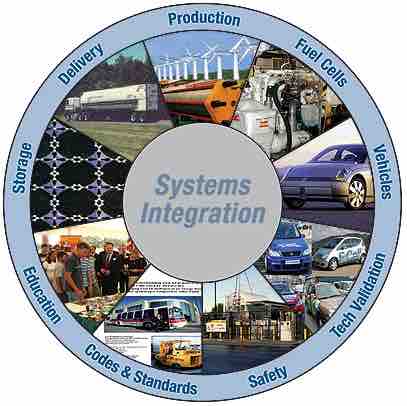Introduction: The Hydrogen Economy
The hydrogen economy refers to a hypothetical future system of delivering energy through the use of hydrogen (H2). The term was first coined by John Bockris at a 1970 talk at the General Motors (GM) Technical Center. Advocates of this proposed system promote hydrogen as a potential fuel source. Free hydrogen does not occur naturally in quantities of use, like other energy sources, but it can be generated by various methods. As such, hydrogen is not a primary energy source, but an energy carrier. The feasibility of a hydrogen economy depends on issues including the use of fossil fuel, the generation of sustainable energy, and energy sourcing.
Comparing Hydrogen Energy to Other Sources
As a potential energy source, the hydrogen economy stands to eliminate or reduce the negative effects of using hydrocarbon fuels, the currently dominant energy source that releases high amounts of carbon into the atmosphere. In the current hydrocarbon economy, transportation is fueled by petroleum, the use of which ultimately results in the release of carbon dioxide (a greenhouse gas) and many pollutants into the atmosphere. In addition, the supply of raw materials that are essential for a hydrocarbon economy is limited, and the demand for such fuels is increasing each year.
As a potential fuel, hydrogen is appealing because it has a high energy density by weight. This results in a 38% efficiency for a combustion engine, compared to 30% when gasoline was used as a fuel. In addition, it provides an environmentally clean source of energy that does not release pollutants. However, there are several obstacles for the use of hydrogen as a fuel, including the purity requirement of hydrogen and difficulties that arise with its storage.
Hydrogen production is a large and growing industry. Globally, 50 million metric tons of hydrogen (equivalent to 170 million tons of oil) were produced in 2004. There are two primary uses for hydrogen today. Half of the hydrogen produced is used to synthesize ammonia in the Haber process. The other half is used to convert heavy petroleum sources into lighter fractions which can be used as fuels. Currently, global hydrogen production is 48% from natural gas, 30% from oil, 18% from coal and 4% from water electrolysis.

The Hydrogen Economy
The hydrogen economy could possibly revolutionize the current energy infrastructure by transferring fuel demands from fossil fuels onto hydrogen.
Methods of Producing Hydrogen
Hydrogen production is mostly accomplished by steam reforming from hydrocarbons, but alternative methods are being developed. Steam reforming is conducted at high temperatures and possesses efficiencies up to 80%. The process involves methane and water and is highly exothermic:
In a second stage, additional hydrogen is generated at a lower temperature:
Other ways of producing hydrogen from fossil fuels include partial oxidation and plasma reforming. Hydrogen can also be produced from water splitting. Fuel cells are electrochemical devices capable of transforming chemical energy into electrical energy. Fuel cells require less energy input than other alternatives and perform water electrolysis at lower temperatures, both of which have the potential of reducing the overall cost of hydrogen production. Water can also be split through thermolysis, but this requires high temperatures and catalysts. In addition, hydrogen can be produced via enzymes and bacteria fermentation, but this technology has not yet been prepared for main scale commercialization. Other methods include photoelectrocatalytic production, thermochemical production, and high temperature and pressure electrolysis.
Obstacles to Adoption of Hydrogen as a Fuel
One major obstacle in the hydrogen economy is its transport and storage. Although H2 has high energy density based on mass, it has very low energy density based on volume. This is a problem because at ambient conditions molecular hydrogen exists as a gas. To be a suitable fuel, hydrogen gas must be either pressurized or liquified to provide enough energy. Increasing the gas pressure will ultimately improve the energy density by volume, but this requires a greater amount of energy be expended to pressurize the gas. Alternatively, liquid hydrogen or slush hydrogen (a combination of liquid and solid hydrogen) can be used. Liquid hydrogen, however, is cryogenic and boils at 20 K, therefore a lot of energy must be expended to liquify the hydrogen.
Storing hydrogen in tanks is ineffective because hydrogen tends to diffuse through any liner material intended to contain it, which ultimately leads to the weakening of the container. Hydrogen can be stored as a chemical hydride or in some other hydrogen-containing compound. These compounds can be transported relatively easily and then decomposed into hydrogen gas. Current barriers to practical storage stem from the fact that high temperatures and pressure are needed for the compound to form and for the hydrogen to be released. Hydrogen can be adsorbed onto the surface of a solid storage material and then be released upon necessity; this technology is still being investigated.
Hydrogen has one of the widest explosive/ignition mix ranges with air. This means that any leak of hydrogen from a hydrogen:air mixture will most likely lead to an explosion if it comes into contact with a spark or flame. This limits the use of hydrogen as a fuel, especially in enclosed areas such as tunnels or underground parking. Pure hydrogen-oxygen flames burn in the UV range and are invisible, so a flame detector is needed to detect if a hydrogen leak is burning. Hydrogen is also odorless, so leaks cannot be detected by smell.
Although the hydrogen economy is supposed to create a smaller carbon footprint, there are many concerns regarding the environmental effects of hydrogen manufacturing. The main source of hydrogen is fossil fuel reforming, but this method ultimately leads to higher emissions of carbon dioxide than using the fossil fuel in an internal combustion engine. Other issues include the fact that hydrogen generation via electrolysis requires a greater energy input than directly using renewable energy, and the possibility of other side products.